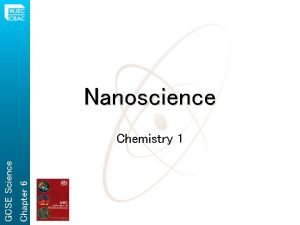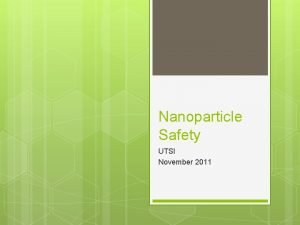Toxicity of platinum nanoparticles to freshwater algae and

- Slides: 1

Toxicity of platinum nanoparticles to freshwater algae and crustaceans Cristina Giron Delgado 1, Sara Nørgaard Sørensen 1, Christian Engelbrekt 2 and Anders Baun 1* 1 Department of Environmental Engineering, Technical University of Denmark 2 Department of Chemistry, Technical University of Denmark *abau@env. dtu. dk Introduction & Objectives Materials & Methods In recent years several nanoparticles types have been studied, however only few studies cover the toxic effects of platinum nanoparticles (Pt. NPs) to aquatic organisms. Pt. NPs and platinum nanostructures can improve the catalytic activity and they have been widely used in automobile catalytic converters for many years. Due to this extensive use, emission of Pt. NPs into the aquatic environment must be expected and the investigation of their ecotoxicity is therefore highly relevant and important. Tested material: Therefore, the aim of this study is to: Crustacean tests with D. magna: 48 h OECD 202 mobility inhibition test 48 h Newly developed anti-sedimentation test: 1) Evaluate of the acute toxicity of Pt. Cl 4 and Pt. NPs towards Pseudokirchneriella subcapitata and Daphnia magna. 2) Investigate the uptake and depuration of Pt. NPs in Daphnia magna. Inhibition Starch coated Pt. NPs of nominal size 1. 7± 0. 2 nm Dissolved platinum reference Algal tests with green algae P. subcapitata: 48 h test OECD 201 growth inhibition test 2 h test Newly developed 2 h 14 C-assimilation inhibition test Daphnia neonates Uptake and depuration test with D. Magna Uptake Depuration during 24 h exposure to Pt. NPs during 24 h in clean medium Net Pt Nps suspension Results: Daphnia Toxicity Results: Algal Toxicity 1 0. 9 0. 8 0. 7 0. 6 0. 5 0. 4 0. 3 0. 2 0. 1 0 Pt. NPs Pt. Cl 4 48 h 1 10 100 Concentration (mg/l) Observed values Log. Norm curve fit 10% effect level 50% effect level Short term test (2 h) in comparison with 48 h: try to minimize the Algae 48 h aggregation, sedimentation and Algae 2 h possible interactions of Pt. NPs. 1000 Pt. Cl 4 (mg Pt/l) EC 50 = 1. 3 [1. 1; 1. 5]95% Toxicity not found Pt. NPs (mg Pt/l) EC 50 = 14 [13; 16]95% EC 50 = 28 [23; 25]95% Pt. NPs mass per alive organism (µg) Results: Uptake / Depuration Daphnia 48 h (antisedimentation test) Pt. Cl 4 (mg Pt/l) IC 50 = 1. 7 [1. 4; 2. 3]95% Not performed Pt. NPs (mg Pt/l) IC 50 = 17 LC 50 = 26 [21; 32]95% IC 50 = 31 LC 50 = 34 Conclusions • Algal toxicity tests: Pt salt is more toxic than Pt. NPs are toxic within 2 h and its toxicity is dependent on the time of exposure. 0. 09 0. 08 Daphnia 48 h (regular test) 1 mg Pt. NPs/l 0. 07 0. 06 • Daphnia toxicity tests: › In the regular test IC 50 > LC 50: significant number of animals were alive but immobile. › In the anti-sedimentation test IC 50 ≈ LC 50: immobilization due to particles settling is almost avoided. Reducing sedimentation, the number of died (immobile) animals are reduced too. 0. 05 0. 04 0. 03 0. 02 0. 01 0. 00 0 2 4 6 8 10 12 14 16 18 20 22 24 26 28 30 32 34 36 38 40 42 44 46 48 Time (h) UPTAKE DEPURATION t= 24 hours Significant increase of Pt. NPs in Daphnia bodies from the 6 th hour to complete the 24 hours of exposure. When the animals are transferred to clean medium, a fast depuration occur. Pt. NPs remain inside the organisms after 24 hours depuration in clean medium. • Algae vs. daphnia toxicity: Almost similar toxicity, however algae is a bit more sensitive to both Pt. Cl 4 and Pt. NPs. • Uptake / Depuration study: Uptake of Pt. NPs in daphnia is initially slow, but increases after 6 h exposure. A very fast depuration is found upon transfer to clean medium. Not all Pt. NPs are depurated in 24 h.

